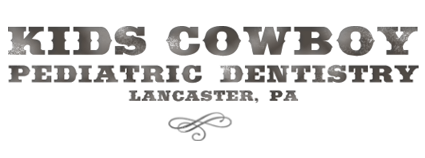The American Academy of Pediatric Dentistry recommends the first dental visit by age 1 to help prevent cavities from developing by reviewing brushing techniques, dietary recommendations, and establish a dental home. If your child goes to bed with a bottle that is not water, is a frequent juice/chocolate milk drinker, uses a sippy cup with liquids other than water or if you have questions please call our office to schedule an appointment because cavities can develop with frequent milk or juice consumption.
Our office is a child-friendly, cowboy/cowgirl themed FUN practice and our team loves to care for children. Dr. Aaron trained for two additional years beyond four years of dental school at Children’s Hospital of Pittsburgh where he specialized solely in caring for children with advanced techniques. Our team knows how to interact with children using kind, supportive, behavior guidance techniques to help them accept treatment. Dr Aaron is also trained in nitrous oxide analgesia, as well as hospital dentistry when extensive dental care is needed. These options allow for more comfortable dental treatment.
We use kind, supportive and caring behavior guidance techniques such as praise, magic tricks, HUMOR, verbal distraction, positive reinforcement, story-telling, singing, and reward. We are also trained in and utilize nitrous oxide and oxygen “fuzzy air” that the child breathes through his/her nose which helps them be more comfortable. This type of analgesia works within five minutes and children are recovered after five to ten minutes of breathing oxygen.
We do not use the gaggy fluoride trays. We apply fluoride varnish using a small dental paint brush. The varnish helps strengthen teeth and prevent cavities. Children may eat and drink right away.
X-rays are taken based on your child’s individual needs in accordance with the recommendations of the American Academy of Pediatric Dentistry. Usually, 2 bitewing X-rays are taken every 12-24 months. We also take a Panorex X-ray, which is required to show wisdom teeth, missing teeth, extra teeth, bone growth, and helps determine the need for braces.
Yes! We have digital intraoral X-ray equipment and a digital extraoral panorex. We use the Planmeca Prosensor HD direct intraoral sensor which allows for less radiation than phosphor plate digital X-ray systems and up to a 70% decrease in radiation compared to film radiograph systems. We also use the Planmeca ProOne panoramic imaging system that shows wisdom teeth, extra or missing teeth, cysts, pathology, as well as growth and development for orthodontic review. This system also provides us the capability to take X-rays that check for between teeth cavities on children with sensitive GAG reflexes by using an extraoral approach that does not cause Gagging!
We offer a Pacifier exchange program if the family is unable to stop the habit on their own. We trade a gift for the pacifier at age 4. The results are great. If a pacifier is taken away too early, we have seen children switch to a finger habit and this is much more difficult to stop.
Yes, many of the beginning orthodontic problems can be prevented or decreased by less involved and less expensive care. This is called preventive and interceptive orthodontic care.
Absolutely, we welcome the family to be with their child for all care.
No. We do not charge for Nitrous Oxide and Oxygen “fuzzy air.” “Fuzzy air” helps children to be less apprehensive. It is a mild pain reliever and for less invasive restorative procedures it can allow for no injection. The gas is breathed through the nose and it can take up to 5 minutes for it to work. Children will breathe 100 percent oxygen at the end of the procedure to reverse the nitrous oxide effect. This mild analgesia option is not indicated for extremely fearful children who will not allow the nose cone, children with epilepsy, active ear infections, to complete extensive treatment at a single visit, and for some very young children do to their inability to breathe the laughing gas.
Our office is a western themed, child-friendly, pediatric dental practice. We have cowboy music and western paintings throughout the office. A large mechanical horse in one of our treatment areas. We have toys, trains, books and games to entertain your buckaroos.
A Pediatric Dentist is required to complete 4 years of college, followed by 4 years of dental school and an additional 2 years of specialty training. The final 2 years of schooling emphasizes gentle psychological approaches required to care for children, the use of sedation and hospital operating room dentistry, preventative and interceptive orthodontic care, restorative dentistry, and learning dental procedural techniques that are child specific.
Baby teeth hold space for permanent teeth and are needed for chewing, speech and esthetics. An infected baby tooth can cause pain, medical compromise and require removal. If a space maintainer is not used to hold the space left after an extraction of the baby tooth orthodontic care may be necessary. Baby teeth in the back typically come out between 10-12 years old.
We are more efficient because our office is designed to only care for children. Our fees are comparable to a family dentist, if not less, while still offering a specialized experience.
Sealants are plastic protective coverings that clog the grooves of posterior adult molars to help prevent cavities. We placed about 2500 a year and have been doing so for over 35 years. If decay develops below a sealant or if it comes off and the child is active in our practice on 6-9month checkups, there is no charge to treat that area. About 112 sealants come off a year; most often from fingernail biting, ice cube chewing, and grinding of teeth called bruxism. About 17 sealed teeth decay a year in our practice. We find this is usually with girls between the ages of 14 to 16 years, who drink pre-sweetened drinks (like iced tea, vitamin water, Gatorade, and chocolate milk) on a daily basis.
Sealants taste a little funny for a few minutes and because they cover the biting surfaces they feel “fat.” After 2 weeks the sealants wear down and only fill the grooves and feel “normal.” Sealants are not usually necessary past age 21 years because of the decline in new cavities due to diet changes and better oral hygiene.
Many insurance programs will pay our office directly and then we bill the family the difference not paid by insurance. If your insurance will pay “out-of-network dentists”, then they will pay our office. We will submit insurance claims on your behalf to have you repaid by your insurance for the plans that reimburse the patient but won’t pay our office. We do require payment at the time of service and any unpaid balances not covered by insurance no later than sixty (60) days. Please provide us with all of your insurance information when you arrive so we may accurately submit claims to your insurance.
We are an “Out of Network” provider and we do not participate with insurance or closed panel groups. Some insurance plans will require you to only see specific dentists of their choice ignorer to use your benefits. Some of these consist of Gateway, Mercy, United Concordia CHIP, Blue Cross/Blue Shield CHIP and UPMC.
We ask that parents be aware of their insurance benefits, deductibles, and limitations prior to visiting our office. There are hundreds of insurance plans and we do not have the ability to know your exact benefits.
The goal of dental insurance, like medical insurance, is to help in affording care but does not pay 100 percent of all treatments. The amount paid is related to the quality of the plan that your employer has selected. Most plans require patients to pay a yearly Deductible, which We keep our fees reasonable and most plans will pay 80-100 percent for routine check-ups, cleaning, x-rays and fluoride. Should you have specific billing or insurance questions, please call our office at 717-569-4597.
As of January 1, 2018, ALL CHIP plans have determined they will no longer provide “Out of Network” payments. In order to use your insurance benefit, CHIP now requires you to find an “IN-NETWORK” dentist. We are happy to care for your children, but CHIP will no longer provide any payment to our office or to the family.
Yes! We have the privilege of training the Pediatric Medical residents from Hershey Medical Center and the Family Practice residents from Lancaster General Hospital as well as instructing the family physicians and pediatricians in the following at the one year well baby check: Children should not go to bed with a sippy cup or bottle with liquids other than water. The frequency of sugary foods and liquids cause cavities, not the amount. Frequent nursing past age one or nursing immediately before bedtime can increase the risk for cavities due to the milk lingering on teeth. Parents should brush children’s teeth until age six years twice a day using a fluoride toothpaste. If a child is below three, they should use a smear of fluoride toothpaste and a pea-sized amount once the child can spit. Parents should use a wet washcloth to wipe the teeth after nursing or before bed.
Our practice provides emergency care for our patients and has an emergency answering service available to answer calls from our patients 24/7. If your child has a dental emergency please call 717-569-4597.
- EMERGENCIES
- If your child has suffered a head injury with loss of consciousness, nausea and vomiting, altered mental status, prolonged or worsening headache, seizures or blurred vision or numbness, call 911 immediately.
- KNOCKED OUT PERMANENT TOOTH
- This is a true dental emergency because there is a 20-30 minute opportunity to save the tooth. If the tooth can be placed back in the socket within this time frame, it may be saved for many years.
- Recover the tooth, making sure to hold it by the crown (top) and not the root end. Rinse, but do not clean or handle the tooth more than necessary. Reinsert the tooth in the socket and hold it in place using a clean piece of gauze or cloth. If the tooth cannot be reinserted, place it in a cup of milk or your child’s saliva. Because time is essential, see a dentist immediately. If your school nurse or sports team coach has a “Save-A-Tooth” container, put the tooth in that container and seek dental care immediately.
- BROKEN TOOTH
- Rinse the area with warm water. Put a cold compress over the facial area of the injury. Attempt to recover any broken tooth fragments. Seek immediate dental attention. If the nerve is exposed, the tooth should be seen by a dentist as soon as possible; if the nerve is not exposed or has only a minor chip, it may be seen the next day. Always contact a dentist to determine if your child needs to be seen and how quickly.
- TOOTH ACHE
- Begin by cleaning around the sore tooth meticulously. Using warm salt water, rinse the mouth to displace any food trapped between teeth. In the event of facial swelling, apply a cold compress to the area. Swelling indicates an immediate emergency usually requiring antibiotic therapy. For temporary pain relief, acetaminophen or other over the counter pain medication is recommended. Contact a dentist as soon as possible.
- CUT OR BITTEN TONGUE, LIP, OR CHEEK
- Ice can be applied to any bruised areas. Cool pops can also be considered. For bleeding, apply firm (but gentle) pressure with sterile gauze or a clean cloth. If the bleeding does not stop with pressure consider biting down on a wet tea bag which contains chemicals to help stop bleeding. Go to an emergency room if bleeding will not stop.
- POSSIBLE BROKEN JAW
- In the event of jaw injury, immobilize the mouth. A towel, tie or handkerchief may be helpful. Go immediately to an emergency room.
Other Urgent Conditions:
- BLEEDING AFTER A BABY TOOTH FALLS OUT
- Fold a piece of gauze and place it (tightly) over the bleeding area. The child should bite down on the gauze for 15 minutes; if bleeding continues, have your child gently bite on a moist tea bag for 10 minutes, which helps stop bleeding. Should bleeding continue, contact a dentist.
- COLD OR CANKER SORES
- Over-the-counter medications will usually provide temporary relief. Avoid acidic foods like orange juice or tomato juice. If sores persist, visit your dentist. These ulcers may be contagious – therefore any medications applied should be with a Q-tip or other applicator.
Your child has suffered an injury to one (or more) of the primary incisors. This sheet is intended to help you understand what you can expect to happen, plus what may occur that will indicate that the tooth is taking a less favorable course.
You Can Expect The Following Reactions:
- Change in eating or sleeping habits: If your child’s normal eating patterns change (in particular I he/she complains when chewing or drinking something cold) or if your child is not sleeping, another evaluation is appropriate.
- Gum abscess: This will appear on the gums in the area above the tooth and will look like a small blister or pimple on the gums and indicate an infection requiring care.
- Increased swelling, looseness or pain: If any of the “expected reactions” do not improve the area should be re-examined by your dentist.
Monday, Tuesday, Wednesday, Thursday, and select Fridays: 8am-5pm
We have installed multiple hand sanitizing stations and,4 Medify air purifiers throughout the office as well as two Reme Halo Ultraviolet virus and bacteria killing systems in our HVAC ductwork. We require masks for all who enter the building. The exceptions to this rule are special needs children who are not able to wear masks, those under two years of age and anyone with a specific physician’s letter indicating a specific medical condition that does not allow for mask wearing. If your child is medically unable to wear a mask, please inform us so that we can try to accommodate a time when other children are not present to minimize health risks. We do have family members who are medically complex and at increased risk, therefore, accommodations will be determined on an individual case basis. We have lengthened our appointment times and have temporarily removed our toys. We have installed televisions and wireless internet for our patients. Our team uses a symptom checklist and temperature check daily.





